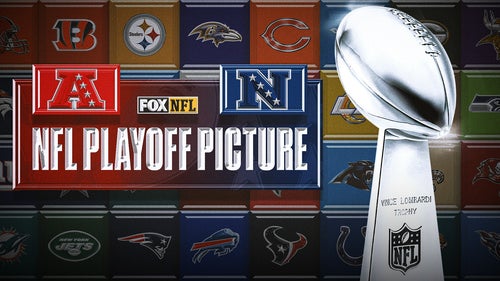
Thin line between idiot, genius in NFL
Coaching is an art form, not a science. Therefore, when a coach makes a decision during the heat of a game, there isn’t necessarily a right and a wrong. Only the outcome will determine whether the correct decision was made.
But that doesn’t mean it will be the correct decision the next time. If the decision works in your team's favor, then it was genius. If it fails, you become the village idiot.
There were a couple of coaching decisions on Sunday that perfectly illustrate my point.
In New Orleans, the Kansas City Chiefs were trailing the Saints by three points when they gained possession with 5:33 remaining in the fourth quarter. Starting at their own 38-yard line, the Chiefs moved the ball into enemy territory by converting a fourth down that placed the ball at the Saints’ 39 with 2:22 remaining. After a first-down run of 6 yards, the Chiefs now had the ball at the 33 with the clocked stopped for the two-minute warning. Rather than attempt to go for the win, the Chiefs elected to run the ball four times in a row and settled for a field goal to force overtime.
It is certainly a fair argument that Romeo Crennel, with the ball at the opponent’s 33, one timeout remaining and 2:00 minutes left on the clock, should have gone for the touchdown to win in regulation. There are many things he had to consider, a turnover being the biggest, but giving the ball back to Drew Brees with time on the clock was probably weighing heavily in his mind. So he decided to run out the game clock, and live to play again in OT. Hard to argue with him considering they won the game.
On the flip side, we saw the Detroit Lions lose to the Titans because they elected to go for it rather than kick the game-tying field goal. Or did they?
The Lions forced overtime by scoring 14 points in the final 18 seconds, including a a recovered onsides kick and ensuing 46-yard Hail Mary The Titans earned first possession in overtime and drove the ball 72 yards before having to settle for a 26-yard Rob Bironas field goal. By rule, the game continues if only a field goal is scored on the first possession of overtime.
The Lions took their ensuing possession all the way down to the Titans’ 7 but were then faced with a fourth-and-1. By rule, the Lions can win the game if they score a touchdown rather than continue overtime with a tying field goal. Jim Schwartz trots his offense back onto the field, he says to attempt to draw the defense offsides. The Lions snap the ball, quarterback Shaun Hill doesn’t get the exchange cleanly and eventually is tackled for no gain. Game over.
I actually don’t mind the aggressiveness of going for the first down in that scenario. In fact, percentages suggest that gaining just one yard is heavily in favor of the offense. But because Schwartz’s team got stopped short, he becomes the village idiot.
But that wasn’t all. Turns out, Schwartz didn’t actually want to snap the ball at all. It was a “miscommunication.” It wasn’t clearly defined where the miscommunication took place, but that is an entirely different set of concerns. This play, the one in which the QB goes to the line, barks his cadence, kicks his leg, sends a man in motion, then another man in motion in an attempt to trick the defense into jumping offsides is practiced every week, without fail. It even has a specific name — usually a one-word name. One that is hard to misinterpret.
How that was miscommunicated is more alarming to me than the aggressive call of going for the win, especially in a game in which you were lucky to still be playing in the first place.
The third situation is one that has been debated among coaches for years. Does icing the kicker really work?
In yet another overtime game on Sunday, the Jets and Dolphins had each come up empty on their first possessions of OT. On their second possession, the Jets drove the ball to the Dolphins’ 15-yard line. On third down, the Jets elected to go for the game-winning 33-yard field goal. The Dolphins pushed through the frontline and blocked the kick, buuuuuuut just before the snap, Miami coach Joe Philbin had called a timeout to ice the kicker.
The effect was just the opposite. On his second attempt, Nick Folk drilled the kick right down the middle for the win.
Philbin had a gut feeling to call that timeout. Again, making in-game decisions is more of an art form than a science, but the scientific approach suggests icing doesn’t work at all. In fact, it works to the advantage of the kicker.
An article published by the Wall Street Journal in 2010, using statistics dating to the 2000 season, found that kickers made 77.3 percent of field goals in the final two minutes when no timeouts were called before the kick but when a timeout was used, kickers actually made 79.7 percent of their attempts. Scientifically speaking, the pre-kick timeout gives the kicker a 2.4 percent advantage.
Interestingly enough, the Wall Street Journal published this article after the Texans’ Gary Kubiak used the tactic against the Redskins during the 2010 season. Graham Gano’s first kick sailed through the uprights, but Kubiak’s timeout nullified it. Gano flubbed his second kick, and the Texans won.
Even with the data showing a 2.4 percent difference, that hardly suggests there being an exact right and wrong when making this decision. On that day in 2010, Kubiak was right and therefore was a genius strategist. On Sunday, Philbin made the exact same decision, but because it didn’t work to his advantage, he becomes the village idiot.
That is the life of an NFL head coach.










